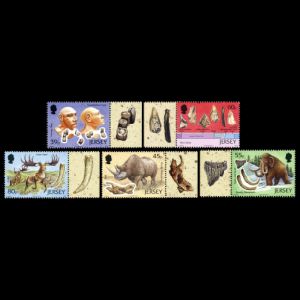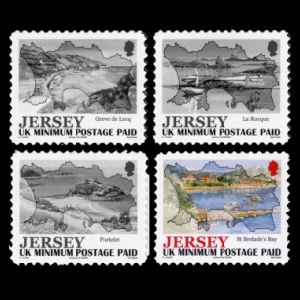the place where Paleontology and Paleoanthropology meets Philately
Jersey
Prehistoric animals, prehistoric humans, paleontologists on stamps and postmarks of Jersey
| << previous country | back to index | next country >> |
Contents:
- Country overview
- Philately of Jersey
- Official stamps of Jersey related to Paleontology
- Some other stamps of Jersey to consider
- Commemorative postmarks of Jersey related to Paleontology
- References
- Acknowledgements
Jersey, officially the Bailiwick of Jersey is a Crown dependency of the United Kingdom, ruled by the Crown in right of Jersey off the coast of Normandy, France.
The bailiwick consists of the island of Jersey, along with surrounding uninhabited islands and rocks collectively named Les Dirouilles, Les Écréhous, Les Minquiers, Les Pierres de Lecq, and other reefs.
Jersey is located some 100 miles south of mainland Britain and is the most southerly of the British Isles. In fact, it's much closer to France, lying just 14 miles from the coast of harbor towns such as Carteret. Despite its compact size - just 9 miles by 5 miles - Jersey possesses a rich and varied landscape which attracts tourists from all over the world.
Jersey was part of the Duchy of Normandy, whose dukes went on to become kings of England from 1066. After Normandy was lost by the kings of England in the 13th century and the ducal title surrendered to France, Jersey and the other Channel Islands remained attached to the English crown.
Jersey is a self-governing parliamentary democracy under a constitutional monarchy, with its own financial, legal and judicial systems, and the power of self-determination. It is not part of the United Kingdom and has an international identity separate from that of the UK, but the United Kingdom is constitutionally responsible for the defence of Jersey. [R1]
The first postage stamps labeled Jersey were issued during the occupation of the island by the Germans during World War II. Later, Jersey used British regional stamps marked specifically for use in Jersey but valid for postage throughout the United Kingdom. Jersey has issued its own stamps since 1 October 1969. Jersey Post is a member of SEPAC, the Small European Postal Administrations Co-operation. [R2]
Official stamps of Jersey related to Paleontology: prehistoric animals and humans, fossils, paleontologists, Charles Darwin
| 11.07.1982 "Historical connections between Jersey and France" [1] | 05.04.1994 "EUROPA: discovery and research" | 12.10.2010 "La Cotte de St. Brelade archaeological site" |
 |
 |
 |
| 14.06.2017 "Durrell & Darwin – 25 Years of the Darwin Initiative" [2] | 05.05.2025 "Europa 2025 - National Archaeological Discoveries" | |
 |
 |
|
Notes:
 [1] Pierre Teilhard de Chardin (1881-1955) was a
French philosopher and Jesuit priest who trained as a paleontologist and
geologist and took part in the discovery of both the Piltdown Man and Peking Man.
[1] Pierre Teilhard de Chardin (1881-1955) was a
French philosopher and Jesuit priest who trained as a paleontologist and
geologist and took part in the discovery of both the Piltdown Man and Peking Man.
Teilhard conceived the idea of the Omega Point and developed Vladimir Vernadsky's concept of Noosphere. Some of his ideas came into conflict with the Magisterium of the Catholic Church, and several of his books were censured.
From 1912 to 1914, Teilhard worked in the paleontology laboratory of the Muse National d'Histoire Naturelle, in Paris, studying the mammals of the middle Tertiary period. Later he studied elsewhere in Europe. [R3]
[2] This stunning issue features the first Jersey stamp printed on wood.
Illustrated by Sara Menon, the animals and birds that feature on the stamps are subjects of conservation projects undertaken by the Durrell Wildlife Conservation Trust with support from the Darwin Initiative, which this year celebrates its 25th anniversary. The Miniature Sheet, which has been printed on FSC certified sycamore, features a portrait of Charles Darwin. The fact that the wood grain can be seen through the image means that each Miniature Sheet is unique.
Somme other stamps of Jersey to consider: fossil locations, contributors to Paleontology
| 29.01.1976 "Parish Arms and Views" [O1] | 17.01.1978 "Parish Arms and Views" [O1] | 20.04.1982 "Historical Events" |
 |
 |
 |
| 08.06.1996 "Jersey Tourism: Beaches" [O1] | 11.07.2006 "Views" [O1] | 28.09.2011 "Jersey Scenery" (3rd series) [O1] |
 |
 |
 |
| 06.07.2023 "150 years of the Société Jersiaise" [O1] | ||
 |
|
|
Notes:
 [O1] St. Brelade (Jereseais: Saint Brélade) is one of the twelve parishes of Jersey.
The parish is the second-largest parish by surface area, covering 12.78 km2, which is 11%
of the total land surface of the island and it occupies the southwestern part of the island.
[O1] St. Brelade (Jereseais: Saint Brélade) is one of the twelve parishes of Jersey.
The parish is the second-largest parish by surface area, covering 12.78 km2, which is 11%
of the total land surface of the island and it occupies the southwestern part of the island. Saint Brelade's Cave has long been known as an important pre-historic site of the Stone Age.
This cave is cut into a granite headland on Jersey's southwest coast. Palaeolithic man, from around 250,000 B.C, occasionally occupied this area which at the time was part of the main Continental landmass. Tribes of hunters followed herds of wild mammoth and woolly rhinoceros on which they depended for food and clothing. Significant archaeological discoveries since 1881 at the cave reveal that these Stone Age men stampeded the animals over the top of the cliff and then butchered them.
Following some preliminary digging it was partially excavated by the late Dr. R. R. Marett in 1913, but the First World War stopped the work, and though it was continued later, the bottom layers were never reached.
Between 1930 and 1960 Father Christian Burdo excavated in the cave where he has found an Acheulean assemblage, a dozen Neanderthal teeth as well as mammoth and reindeer bones.
The bone in his hands, on the stamp, seems as one of the mammoth ribs he discovered in the cave. The site has produced more Neanderthal stone tools than the rest of the British Isles put together.
The cave and some fossils discovered in the cave, were shown on several stamps of Jersey: "EUROPA: discovery and research" in 1994 and "La Cotte de St. Brelade archaeological site" in 2010.

Strip from a bottom of stamps-sheet "EUROPA: discovery and research" from 1994
La Cotte de St Brelade is a Neandertal site in St Brelade, Jersey. Neanderthals lived there from around 238 000 years ago until between 100 000 and 40 000 years ago - making it the earliest known the occupation of the Channel Islands by a hominin species, and also possibly one of the last Neanderthal sites in northwestern Europe. At that time, with sea levels below those at present, Jersey was part of Normandy, a peninsula jutting out from the coast. After the last Ice Age the sea rose again, separating Jersey from the mainland. [R4]
Commemorative postmarks of Jersey related to Paleontology: fossils
Legend is here| 12.10.2010 "La Cotte de St. Brelade archaeological site" [2] [FDC] | ||
 |
|
|
References:
- [R1] Jersey:
Wikipedia,
WikiTravel,
FlagCounter.
- [R2] Postal History and Philately of Jersey:
Wikipedia,
Links to official website of the Post Authority, stamp catalog and a list of new stamps of Jersey are here - [R3] Pierre Teilhard de Chardin : Wikipedia, Paleoanthropologists on stamps.
- [R4] La Cotte de St Brelade:
Wikipedia,
donsmaps.com.
- Saint_Brelade: Wikipedia.

|
Many thanks to
- Dr. Peter Voice from Department of Geological and Environmental Sciences, Western Michigan University, for reviewing the draft page and his valuable comments.
- fellow collector Mr. Peter Brandhuber from Germany, for his help in finding some missing philatelic stuff of Jersey.
| << previous country | back to index | next country >> |